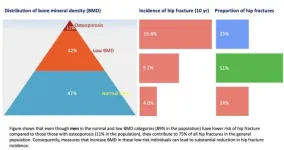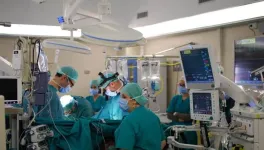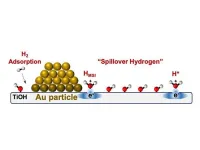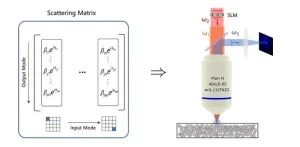(Press-News.org) Simple strategies to strengthen your bones, implemented by the whole community not just those at higher risk, could lead to a substantial decrease in hip fractures, a new Australian study suggests.
A hip fracture, particularly in the elderly, dramatically increases the risk of death. Around 37 per cent of men and 20 per cent of women die within one year of a hip fracture. It also causes significant pain and suffering, loss of mobility and independence, and increased healthcare costs.
Distinguished Professor Tuan Nguyen, a world-leading researcher in osteoporosis from the University of Technology Sydney (UTS) who spearheaded the study, said it is important for people to take simple measures to improve their bone health, even if they don’t have osteoporosis, and even if the measures seem to have minor benefits to them.
“Osteoporosis is a disease characterised by weak and brittle bones caused by bone loss. Osteoporotic individuals have the highest risk of a hip fracture, and pharmacologic treatment can reduce this risk by around 50 per cent,” said Professor Nguyen.
“However, the majority of hip fractures occur in people who do not have osteoporosis, so it is important for everyone, especially the elderly, to take action to improve their bone health. Bone mineral density is modifiable, and even small improvements reduce the risk of a fracture.
“Bone health is affected by lifestyle factors such as smoking, physical activity and nutrition, including vitamin D and dietary calcium intake. Stopping smoking, maintaining moderate physical activity, and eating a healthy diet can all help reduce bone loss.”
The study ‘Prevention of hip fractures: trade-off between minor benefits to individuals and large benefits to the community’ was recently published in the Journal of Bone and Mineral Research, with co-authors from The Garvan Institute of Medical Research and UNSW Sydney.
The researchers analysed data from the Dubbo Osteoporosis Epidemiology Study, one of the longest running studies on osteoporosis in the world. It includes more than 3000 individuals over 60 years of age, who have been tracked over time for fracture incidence and risk factors.
They found that between the first cohort in 1988-92 and the second in 1999-2001, bone mineral density increased by 3 per cent. During the same period, there was a 45 per cent decrease in hip fractures, a decline typically associated with a 10 per cent rise in bone mineral density.
British epidemiologist Geoffrey Rose postulated that a population-based measure bringing a small benefit to each individual can yield large benefits to the community. The current study supports this axiom, by showing a small increase in bone density led to a substantial reduction in hip fractures.
Professor Nguyen draws a parallel with wearing a car seatbelt. “Wearing a seatbelt might bring little benefit to an individual because the probability of having a car accident is very low, but we know this simple action does save lives in the community.”
“Some people who are following medication regimens or engaging in lifestyle modification programs and notice a slight change in bone mineral density might believe that these measures hold little benefit for them. Nonetheless, even these minor effects can lead to a substantial reduction in fracture risk for the community,” he said.
Epidemiologist and first author Dr Thach Tran said the study findings will be of interest to public health policymakers and medical professionals, as well as individuals who want to reduce their risk of a hip fracture.
“Our study suggests that population strategies focused on reducing risk in those at low or moderate risk are likely to be more effective than strategies just focused on high-risk individuals,” he said.
“The findings also imply that the categorization of bone mineral density into osteoporosis or non-osteoporosis based on an arbitrary threshold is not an optimal approach for identifying people at high risk of fracture.”
END
How little things can reduce hip fractures
Simple strategies to strengthen your bones, implemented by the whole community not just those at higher risk, could lead to a substantial decrease in hip fractures, a new Australian study suggests.
2023-09-01
ELSE PRESS RELEASES FROM THIS DATE:
Heart transplant patients from socioeconomically distressed communities face higher mortality, organ failure risk
2023-09-01
FINDINGS
People from socioeconomically distressed communities who underwent heart transplantation between 2004 and 2018 faced a 10% greater relative risk of experiencing graft failure and dying within five years compared to people from non-distressed communities. In addition, following implementation of the 2018 UNOS Heart Allocation policy, transplant recipients between 2018 and 2022 faced an approximately 20% increase in relative risk of dying or experiencing graft failure within three years compared with the pre-policy period. This is despite the ...
Striking gold with molecular mystery solution for potential clean energy
2023-09-01
UNIVERSITY PARK, Pa. — Hydrogen spillover is exactly what it sounds like. Small metal nanoparticles anchored on a thermally stable oxide, like silica, comprise a major class of catalysts, which are substances used to accelerate chemical reactions without being consumed themselves. The catalytic reaction usually occurs on the reactive — and expensive — metal, but on some catalysts, hydrogen atom-like equivalents literally spill from the metal to the oxide. These hydrogen-on-oxide species are called "hydrogen ...
Blood biomarker shows “great promise” predicting progression to Alzheimer’s disease in at-risk population
2023-09-01
DETROIT – Neuroscience researchers at Wayne State University published a review article that confirms the usefulness of neurofilament light (NfL) blood levels to predict the likelihood and rate of progression of neurodegeneration in Alzheimer’s disease. Blood-based NfL is a minimally invasive and easily accessible biomarker, making it a useful clinical biomarker. Youjin Jung and Jessica Damoiseaux, Ph.D., analyzed existing literature to examine the association between serum or plasma NfL and ...
Redo transcatheter aortic valve replacement proven effective, safe
2023-09-01
Cedars-Sinai investigators are leaders in the innovation and use of transcatheter aortic valve replacement (TAVR) with balloon-expandable valves. They now show that redo TAVR procedures are both safe and effective when compared with situations in which patients with similar risk profiles undergo the same procedure for the first time.
The novel findings, published today in the peer-reviewed journal The Lancet, are significant because recent randomized clinical trials have shown that TAVR is a meaningful treatment option for both younger and lower-risk surgical ...
Inflammation may influence weight loss surgery outcomes, new study reveals
2023-09-01
Research funded by the National Institute for Health and Care Research (NIHR) has shown that higher levels of inflammation in the blood of patients with obesity undergoing bariatric surgery predicts poorer weight loss six months after the procedure.
Published in Psychological Medicine and led by researchers from the Institute of Psychiatry, Psychology & Neuroscience (IoPPN), King’s College London, this is the first study to investigate the links between depression and inflammation in patients with obesity before and after bariatric surgery. The analysis showed a strong relationship ...
Study shows that low-dose aspirin associated with a 15% lower risk of developing diabetes in people aged over 65 years
2023-09-01
*Note- this is an early release from the Annual Meeting of the European Association for the Study of Diabetes (EASD) meeting in Hamburg, October 2-6. Please credit the meeting if you use this story*
New research to be presented at this year’s Annual Meeting of the European Association for the Study of Diabetes (EASD) in Hamburg, Germany (2-6 October) shows that use of low dose (100mg daily) aspirin among older adults aged 65 years and older is associated with a 15% lower risk of developing type 2 diabetes. The authors, led by Professor Sophia Zoungas, School of Public Health and Preventive Medicine, ...
New grant to optimize gut microbes, boost health benefits of broccoli
2023-08-31
URBANA, Ill. — Love it or hate it, broccoli is chock-full of health-promoting chemicals linked to heart health, cancer prevention, immune function, weight management, and more. However, some people are less efficient than others at unlocking those chemical benefits. A research team at the University of Illinois Urbana-Champaign suggests gut microbe communities may be responsible for the variation. With a new grant from the USDA’s National Institute of Food and Agriculture, the team plans to identify which microbes maximize the benefits of broccoli and other brassica ...
Illuminating new horizons: Navigating nonlinear scattering with precision
2023-08-31
In the intricate world of light, a journey through inhomogeneous media often leads to distortions in space, time, spectrum, and polarization. These distortions, detrimental to applications like optical manipulation, imaging, and communication, have long posed a challenge. Enter the art of wavefront shaping (WS) — a potent tool for correcting these wave maladies in linear optics. But that's not all. Nonlinearity adds a twist, finding purpose in fields from biological sensing to phototherapy. Now, picture combining these forces — ...
Digging deeper into how vaccines work against parasitic disease
2023-08-31
COLUMBUS, Ohio – Scientists have established the effectiveness of vaccines they developed to prevent the disfiguring skin disease leishmaniasis in animal studies, and Phase 1 human trial planning is in motion for the most promising candidate.
But in new work, the research team has determined how these vaccine candidates, created using mutated disease-causing parasites, prompt molecular-level changes in host cells that have specific roles in helping generate the immune response.
Despite using the same CRISPR ...
Housing heroes: New program to support veterans experiencing homelessness
2023-08-31
Since 2009, the number of veterans experiencing homelessness across the United States has shrunk by more than 50%, according to a 2022 Department of Housing report.
With the support of a $150,000 grant from the Department of Veterans Affairs (VA), the University of Missouri School of Law Veterans Clinic is aiming to continue this trend here at home with a new program designed to further empower veterans in taking steps out of homelessness.
The Veterans Outreach Program will help attorneys connect with veterans experiencing homelessness with the goal of offering them the legal assistance ...
LAST 30 PRESS RELEASES:
Why nail-biting, procrastination and other self-sabotaging behaviors are rooted in survival instincts
Regional variations in mechanical properties of porcine leptomeninges
Artificial empathy in therapy and healthcare: advancements in interpersonal interaction technologies
Why some brains switch gears more efficiently than others
UVA’s Jundong Li wins ICDM’S 2025 Tao Li Award for data mining, machine learning
UVA’s low-power, high-performance computer power player Mircea Stan earns National Academy of Inventors fellowship
Not playing by the rules: USU researcher explores filamentous algae dynamics in rivers
Do our body clocks influence our risk of dementia?
Anthropologists offer new evidence of bipedalism in long-debated fossil discovery
Safer receipt paper from wood
Dosage-sensitive genes suggest no whole-genome duplications in ancestral angiosperm
First ancient human herpesvirus genomes document their deep history with humans
Why Some Bacteria Survive Antibiotics and How to Stop Them - New study reveals that bacteria can survive antibiotic treatment through two fundamentally different “shutdown modes”
UCLA study links scar healing to dangerous placenta condition
CHANGE-seq-BE finds off-target changes in the genome from base editors
The Journal of Nuclear Medicine Ahead-of-Print Tip Sheet: January 2, 2026
Delayed or absent first dose of measles, mumps, and rubella vaccination
Trends in US preterm birth rates by household income and race and ethnicity
Study identifies potential biomarker linked to progression and brain inflammation in multiple sclerosis
Many mothers in Norway do not show up for postnatal check-ups
Researchers want to find out why quick clay is so unstable
Superradiant spins show teamwork at the quantum scale
Cleveland Clinic Research links tumor bacteria to immunotherapy resistance in head and neck cancer
First Editorial of 2026: Resisting AI slop
Joint ground- and space-based observations reveal Saturn-mass rogue planet
Inheritable genetic variant offers protection against blood cancer risk and progression
Pigs settled Pacific islands alongside early human voyagers
A Coral reef’s daily pulse reshapes microbes in surrounding waters
EAST Tokamak experiments exceed plasma density limit, offering new approach to fusion ignition
Groundbreaking discovery reveals Africa’s oldest cremation pyre and complex ritual practices
[Press-News.org] How little things can reduce hip fracturesSimple strategies to strengthen your bones, implemented by the whole community not just those at higher risk, could lead to a substantial decrease in hip fractures, a new Australian study suggests.





